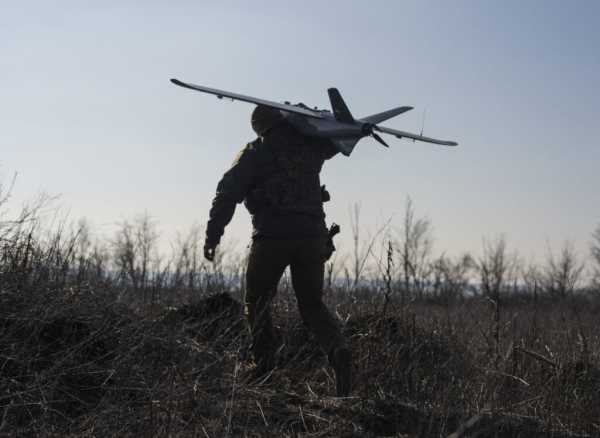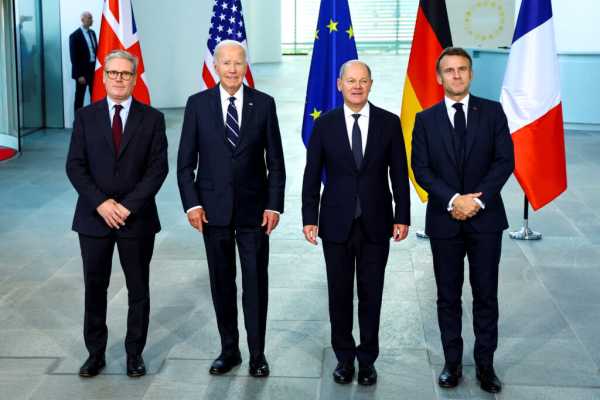
The Russia-Ukraine War has become the proving ground for some of the latest innovations in military technology. This is most immediately apparent in the rapid evolution of unmanned aerial vehicles (UAVs) or drones. These range from reconnaissance and surveillance drones, which maintain an “eye in the sky” above the battle space, to combat UAVs that drop munitions and kamikaze drones used to strike enemy targets.
At sea, Ukrainian marine drones have swarmed enemy warships, sinking or seriously damaging a large portion of the Russian Black Sea fleet and chasing it out of Sevastopol port in the occupied Crimean peninsula. Ukraine is also starting to field unmanned ground vehicles (UGVs) in logistics, supply, evacuation, and combat roles.
Since the start of Russia’s full-scale invasion in February 2022, the Ukrainians have often had the upper hand in drone development and deployment. However, as with any new weapon, the opposing side typically moves quickly to devise effective countermeasures against their opponent’s advantage and develop similar weapons of their own. This relentless arms race has been a key feature of the war in Ukraine throughout the past two and a half years.
According to US military experts, the window between the first deployment of an improved drone design and the appearance of countermeasures is usually just over a month. Responses can range from electronic interference to copying drone designs and combat tactics. It is a lethal game of whack-a-drone that has led to the testing of, among other technologies, autonomous target acquisition and increasingly autonomous drone operations.
International observers including opponents of the West are carefully studying how the defense tech innovations that are emerging in Ukraine will shape the future of warfare. Unsurprisingly, military cooperation among autocracies is already expanding as the Kremlin and its allies look to share knowledge and experience. For example, Iran has reportedly been providing training to Russian drone operators.
Western military planners are in turn learning from their Ukrainian partners about adapting commercially available platforms to military applications in an extremely challenging environment. Ukraine’s inventiveness and ability to establish mutually beneficial cooperation between tech startups and the state have amazed Western military experts, who are more accustomed to slow and highly bureaucratic processes.
When it comes to learning the defense tech lessons of the Russia-Ukraine War, there is no substitute for being close to the battlefield. Observing Ukrainian drone operators at work, interacting closely with electronic warfare specialists, and participating in the deconstruction and analysis of recovered Russian drones are all vital to understanding how these technologies are evolving.
Many Western journalists and volunteers are already embedding themselves with Ukrainian units as they seek to learn more about the realities of modern warfare and the increasingly central role being played by defense tech innovations. This close proximity could be highly beneficial for military commanders and defense industry developers. However, that would require a far more comprehensive approach.
At present, Western efforts to learn from the war in Ukraine are being impeded by an extreme aversion to putting any personnel at risk. Fears over the possible consequences of injury or death to non-Ukrainian personnel in the war with Russia appear to be inhibiting Western governments and weapons manufacturers. These concerns are limiting their ability to study the remarkable developments currently taking place in Ukraine.
This is not necessarily the case elsewhere. For instance, US military personnel are currently deployed in a number of active conflict zones in the Middle East and Africa. In contrast, the movements of Western military personnel in Ukraine remain heavily restricted, even in a purely observational role.
While there is a strong case for allowing military personnel to get closer to the front lines in Ukraine, it is arguably even more important to provide weapons developers with direct access. Indeed, some smaller Western military equipment manufacturers have already sent experts to Ukraine. Mainstream manufacturers now need to overcome their reluctance and allow key staff greater access to the Ukrainian front lines.
Today’s self-imposed constraints are limiting the West’s opportunities to get a closer look at what the battlefield of the not-too-distant future will look like. This is making it harder to provide Ukraine with the support it needs to win the current war, while also preventing the development of new defense tech capabilities that can help keep Western societies safe in the coming decades.
Edward Verona is a nonresident senior fellow at the Atlantic Council’s Eurasia Center covering Russia, Ukraine, and Eastern Europe.
Source: euractiv.com



